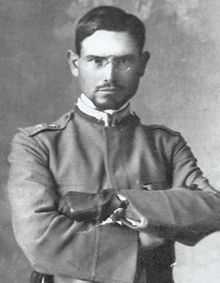Emilio Lussu
| Emilio Lussu | |
|---|---|
 | |
| Born |
December 4, 1890 Armungia (Sardinia) |
| Died |
March 5, 1975 Rome |
| Occupation | soldier, politician and writer |
| Spouse(s) | Joyce Lussu |
Emilio Lussu (December 4, 1890 – March 5, 1975) was an Italian soldier, politician and a writer.
Biography
The soldier
Lussu was born in Armungia, province of Cagliari (Sardinia) and graduated with a degree in law in 1914. Lussu married Joyce Salvatori, a notable poet, and member of the noble family of the Marche.
Prior to the entry of Italy into World War I, Lussu joined the army and was involved in several skirmishes. As a complementary officer of the Sassari Infantry Brigade in 1916 he was stationed on the Asiago Plateau. The brigade had arrived on the plateau in May 1916 to help in the Italian effort to stop the Austrian Spring offensive. In the month of June 1916 the brigade conquered Monte Fior, Monte Castelgomberto, Monte Spil, Monte Miela and Monte Zebio. After the war Lussu wrote the book A Year on the High Plateau (Un anno sull'altipiano) about his experiences of trench warfare on the Plateau.
Politics and exile
After the war Lussu, together with Camillo Bellieni, founded the Partito Sardo d'Azione (The Sardinian Action Party), that blended social-democratic ideas and Sardinian autonomy. The party took a formal position in 1921, opposing the increasing power of the Fascist movement. Lussu was elected to the Italian parliament in 1921 and, in 1924 was among the Aventine secessionists who withdrew from the Italian Parliament after the murder of Giacomo Matteotti.
Lussu's anti-Fascist position was, at the time, one of the most radical in Italy. Lussu was physically attacked and injured by unknown aggressors several times. In 1926, during one of these attacks (notably, the same day that Benito Mussolini suffered an attack in Bologna), Lussu shot one of the squadristi, in self-defense. He was arrested and tried; and was acquitted. However, he was re-tried by an administrative Fascist commission and sentenced to 5 years of confinement on the island of Lipari, near Sicily.
In 1929 Lussu escaped from his confinement and reached Paris. There, together with Gaetano Salvemini and Carlo Rosselli he formed Giustizia e Libertà (Justice and Freedom), an anti-Fascist movement that proposed revolutionary methods to upset the Italian Fascist Regime. While in exile came to be known as "Mister Mills".
In 1938 Lussu's novel Un anno sull'altipiano ("A Year on the Plateau"), was published in Paris. This thinly fictional account tells of the lives of soldiers during World War I and the trench warfare they encountered. Un anno sull'altipiano underlines, with chill rationalism, how the irrationalities of warfare affected the common man. Gifted with a keen sense of observation and sharp logic, Lussu demonstrates how distant the real life of soldiers is from everyday activities. In a notable passage, he describes the silent terror in the moments preceding an attack, as he is forced to abandon the "safe" protective trench for an external unknown, risky, undefined world: “All the machine-guns are waiting for us”.
Return to Italy

In 1964 he separated from the Socialist Party creating the Italian Socialist Party of Proletarian Unity (PSIUP). Ideological differences with the political line of Partito d'Azione deepened and Lussu left Sardinia.
Emilio Lussu died in Rome in 1975.
Works
Many political meanings have been drawn from Lussu's works, but his works are perhaps more important at a personal level. Morally and philosophically, Lussu's books reflect his need to repent, having been previously an interventista (favourable to entering the war) and a revolutionary (in Giustizia e Libertà); his works soberly describe what war, in its cruellest moments, was like for him.
The alteration of Lussu's opinion of war is quite apparent in the range of his works: first an interventista, then the author of a manual for revolution, soon afterwards the author of a pacifist book, then again a revolutionary and a volunteer in the Spanish civil war. Anyway, A Year on the High Plateau combines well the repulse of the war with the bravery of the fighter.[2] Lussu's consistency has been questioned and politics often invades evaluations of his works.
Bibliography
- La catena (1929)
- Marcia su Roma e dintorni (The March on Rome and Thereabouts, 1932)
- Teoria dell'insurrezione ("Theory of Insurrection", 1936)
- Per l'Italia dall'esilio (Road to exile: the story of a Sardinian patriot, 1938) (Review in Time Magazine)
- Un anno sull'altipiano ("A Year on the High Plateau", Sassari Infantry Brigade, 1938, ISBN 978-1-85375-360-2)
- Diplomazia clandestina" (1955)
- La clericalizzazione dello Stato e l'arcivescovo di Cagliari (1958)
- Il cinghiale del diavolo e altri scritti sulla Sardegna (1976)
References
- ↑ Mireno Berrettini, La Gran Bretagna e l'Antifascismo italiano. Diplomazia clandestina, Intelligence, Operazioni Speciali (1940–1943), Firenze, 2010
- ↑ Giulio Angioni, Emilio Lussu e i sardi, in Il dito alzato, Sellerio, 2012
Sources
- Rossi, Umberto. "The Alcoholics of War: Experiencing Chemical and Ideological Drunkenness in Emilio Lussu’s Un anno sull’altipiano”, Mosaic, 38:3 September 2005, 77–94.
|